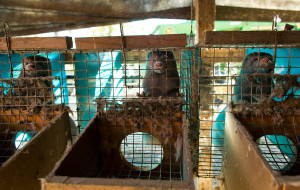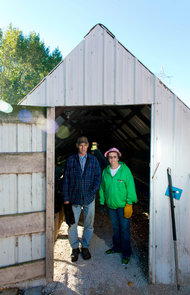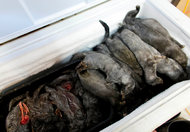The New York Times
Michael Wines
October 16. 2013
NEW HOLSTEIN, Wis. — Next to their white clapboard house on a rural road here, in long rows of cages set beneath the roofs of seven open-air sheds, Virginia and Gary Bonlander are raising 5,000 minks. Or were, anyway, until two Saturdays ago, when the police roused them from bed at 5 a.m. with a rap on their door.
 Outside, 2,000 minks were scampering away — up to 50 top-quality, full-length and, suddenly, free-range mink coats.
Outside, 2,000 minks were scampering away — up to 50 top-quality, full-length and, suddenly, free-range mink coats.

The Bonlanders woke one recent morning to find thousands of the creatures zipping across their lawn.
“The backyard was full of mink. The driveway was full of mink,” Mrs. Bonlander recalled a few days ago. “Then, pshew” — she made a whooshing sound — “they were gone.”
And not only in Wisconsin, the mink-raising capital of the United States. After something of a hiatus, the animal rights movement has resumed a decades-old guerrilla war against the fur industry with a vengeance — and hints of more to come.
In New Holstein; in Grand Meadow, Minn.; in Coalville, Utah; in Keota, Iowa; and four other states, activists say, eight dark-of-night raids on mink farms have liberated at least 7,700 of the critters — more than $770,000 worth of pelts — just since late July. That is more such raids than in the preceding three years combined.
Two more raids in Ontario and British Columbia freed 1,300 other minks and foxes during the same period, according to the North American Animal Liberation Press Office, which bills itself as a conduit for messages from anonymous animal rights activists.
“What we’re seeing now is unprecedented,” Peter Young, a Santa Cruz, Calif., activist who was imprisoned in 2005 for his role in raids on six mink ranches, said in a telephone interview. Though still an outspoken defender of the animal rights movement and mink-ranch raids, Mr. Young says he has no contact with those who raid fur farms or commit other illegal acts and, in fact, does not know who they are.
The fur industry is not amused. “Criminal thugs, felons. And they’re committing federal crimes,” said Michael Whelan, the executive director of Fur Commission U.S.A., which represents all of the country’s 300 or so mink farms.
Also, he adds, it is not unprecedented. Mr. Whelan says raids were more common during the 1990s, and he even disputes that eight raids have occurred since July. (He says there were only seven.)
It is one measure of the venomous relationship between mink ranchers and mink liberators that they cannot agree on how big their argument is. But it is only one measure.
The two camps also call each other terrorists. Indeed, mink liberation is a federal crime under the Animal Enterprise Terrorism Act, and animal rights extremism is duly monitored by the Department of Homeland Security, according to a 2012 Congressional report.
Mr. Young, who says he is regularly searched at airport security checkpoints when he flies these days, maintains that the only violence in his old line of work occurred when farmers harvested their pelts for sale at auction.
The two sides do agree on one matter: that the raiders — the shadowy Animal Liberation Front, the best-known such group, has claimed responsibility for three of the recent attacks — are extremists.
“Fur is just a gateway product,” Mr. Whelan said. “They’re against the production of leather, meat, wool, poultry, dairy. The reason they’re after the fur industry is because it’s low-lying fruit.”
Mr. Young quite agrees. “This really isn’t about fur in particular; it’s about animal exploitation,” he said. “If cows were able to survive in the wild and had a natural habitat, we’d release cows. Unfortunately, you can’t release a cow, so we have to release mink.”
Not that cows are not on the animal rights agenda. In August, a group called Iowans for Animal Liberation poured red paint over the Iowa butter cow, a life-size cow carved in butter that is a highlight of the state fair, to symbolize the blood animals shed on the way to being eaten, worn and otherwise exploited.
But for those who release animals from captivity, fur, and especially mink, appears to deliver the most bang for the buck.
The latest burst of raids appears to stem in part from an anonymous posting on a blog this summer of an updated list of mink and fox farms and research facilities first issued in 1996. The new list, called The Final Nail #4, includes addresses, instructions on how to free animals from cages and avoid detection, and a most-wanted list of desirable targets.
But the activists may also be aiming for the farmers’ pocketbooks. Driven by demand from nouveau riche Chinese and Russians, the price of a good mink pelt has zoomed to a record $100, Fur Commission U.S.A. estimates, from just $41 five years ago, and turned a handful of mostly backyard businesses into a $350 million-a-year industry.
“The Chinese consumer just loves the American mink,” said Mr. Whelan of the fur commission. “They want all the trappings of success. They want the Mercedes-Benz, they want the Rolex watch and they want the mink coat. We’re fortunate to be a part of it.”
In New Holstein, 90 minutes north of Milwaukee, the Bonlanders say their 5,000 minks, housed on the family plot, are just a small business. Still, they were just completing work on a massive new freezer to hold their furry harvest when the raiders struck.
Mrs. Bonlander called the raid “devastating,” adding: “It’s our livelihood. They’re trying to put us out of business. Do you feel bad about killing a cow? Or the pig for pork chops? That’s the way it is.”
But she claims to have had the last laugh.
Within an hour of the police officer’s knock, she said, “There was about a hundred people here catching mink,” friends and neighboring mink farmers and strangers who had heard about the raid over the telephone grapevine. In boots and biteproof gloves, with fishing nets and live traps and even a mink-sniffing dog, they set out to round up their quarry.
“They’re hard to catch,” she said. “They’re slippery, they’re quick and they’re sly.” But surprisingly, she claims the family recovered all but 180 or so.
Some of the lost were squashed on the road by passing cars. The rest, she said, will not make it through the winter. “They weren’t born in the wild. Their mothers didn’t train them to hunt,” she said. “These people that release the mink, they don’t think of that.”
Many wildlife biologists disagree; escaped minks are thriving in Britain, New Zealand and elsewhere. For his part, though, Mr. Young says that is not the point. “The animals on these farms are bred to be killed. That’s a 100 percent certainty,” he said. “If even one animal gets away and survives, that’s a success as far as I’m concerned.”


